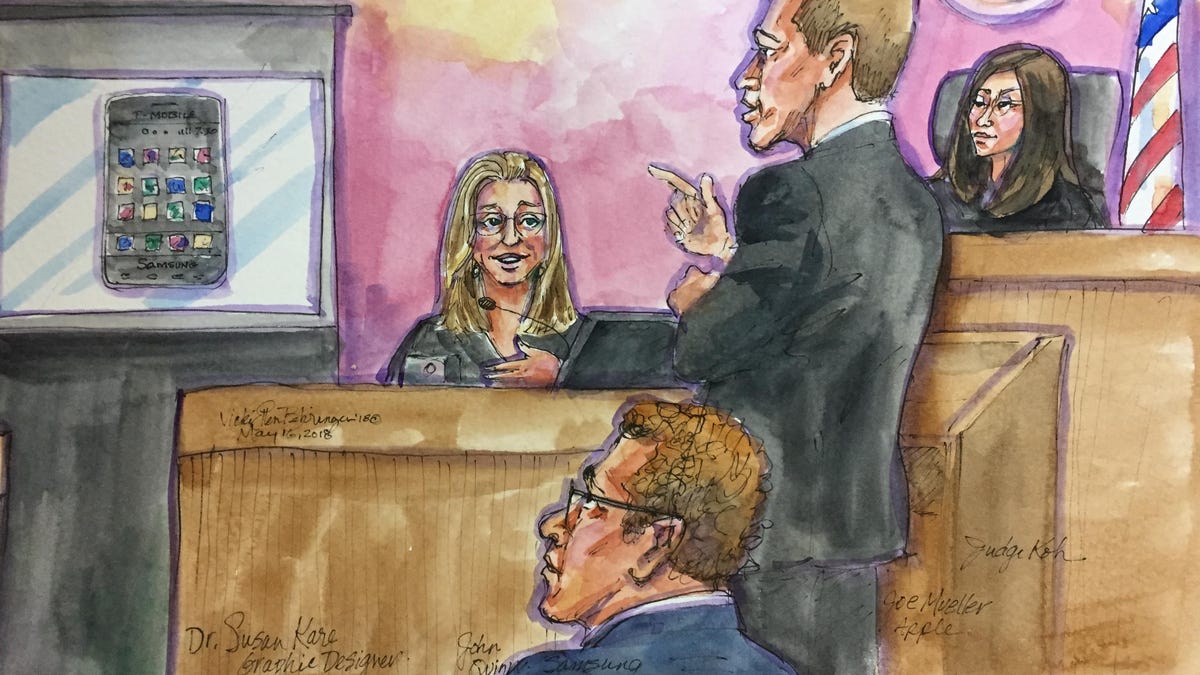Apple-Samsung patent trial puts designers on the hot seat
Among those testifying is Susan Kare, who designed the icons for the original Mac.

Susan Kare, creator of the icons on the original Macintosh, testifies for Apple at a trial to determine Samsung patent infringement damages.
The verbal sparring began in earnest Wednesday between Samsung lawyers and Apple witnesses as the two tech titans got to the heart of their dispute over how much Samsung must pay Apple for patent infringement.
Two Apple expert witnesses -- industrial designer Alan Ball and graphic designer Susan Kare, who designed the icons for the original Macintosh computers in the early 1980s -- agreed with Apple's view of the matter. But Samsung attorneys managed to extract some limited acknowledgements from the two that the lawyers doubtless hope will help steer jurors toward its way of thinking.
An earlier trial in the seven-year case already determined that Samsung infringed three Apple design patents, which cover ornamental elements of a product, and two functional patents, which govern how a product works. The central dispute that remains is whether to base Samsung's damages payment on the profits from entire phones, as Apple argues, or just from some components, as Samsung believes.
At stake is whether design patents, which govern ornamental aspects of products, are powerful tools to keep competitors at bay or relatively limited in power. Apple -- where good design is job one, company executives testified Tuesday -- is pushing for power. It's seeking more than $1 billion in damages from Samsung for infringing the three design patents.
The key point involves an old and abstruse legal term, the "article of manufacture" that incorporates the patented design. A 2016 Supreme Court decision opened the door for basing damages on components, not the entire phone, but ultimately the decision will rest with the jury in US District Court in San Jose, the heart of Silicon Valley. Check CNET's FAQ for the full background on the case.
One law school professor not involved with the case sees things Samsung's way.
"Apple's theory would lead to an award that is totally disproportionate to any actual harm suffered. And while Samsung can afford to fight this type of claim, not every accused infringer can," Sarah Burstein, a University of Oklahoma law professor who studies the article of manufacture issue, said in an interview.
"I agree with Samsung on this one," she said. "After looking into the historical meaning of the phrase 'article of manufacture,' it's clear Congress didn't intend for someone to be able to patent a design for a screen and get the profits from the whole phone."
Designers on the stand
Ball evaluated the article of manufacture issue for two Apple design patents, US Patent No. D618,677 (D'677 for short), which describes a black, rectangular, round-cornered front face for an electronic device, and US Patent No. D593,087 (D'087), which describes a similar rectangular round-cornered front face plus the surrounding rim called a bezel. Kare did the same evaluation but for US Patent No. D604,305 (D'305), which describes a grid of colorful icons.
"To me, no question -- in each case, the D'305 [patent] was applied to each of these finished phones -- the whole phone," Kare said.
Alan Ball, an independent industrial designer, testifies in US Northern California District Court in San Jose about Apple iPhone design patents Samsung was found to infringe.
And for the D'677 and D'087 patents, Ball said the Samsung articles of manufacture are "the entire smartphones."
Yes, phones are made of components
An illustration from Apple's US Patent No. D604,305 (D'305), a design patent that describes a grid of icons
But Samsung lawyers worked hard to get the witnesses to acknowledge that phones are made of components even if those components aren't ordinarily something a person might buy.
"I get that a display screen is a thing," an article of manufacture along with other components, Kare said. And she accepted that in the design patent illustrations, some elements of the phone drawn with dotted lines are not part of what Apple claimed in the patent.
But she stuck to her overall position that it's an "organic, holistic design" that infringes Apple's D'305 patent. And asked whether the icons governed by D'305 appear on a phone's screen, she said, "Honestly, I'd say you see it on the phone."
Ball also pointed to "unitary or monolithic" phone designs. He acknowledged that phones could be disassembled with the right tools, "but we have to look at whether it was intended," he said. "Just because you can take something apart doesn't mean it was designed to be that way. If you replace [a component], you're trying to get back to that thing that you bought."
What about a medical device?
Samsung attorney Bill Price also asked Ball to imagine a medical device that looked just like one of the infringing Samsung phones but actually was a revolutionary scanner that could detect cancer and was worth millions of dollars.
Accountant Julie Davis, a witness called by Apple, calculated that Samsung should pay Apple more than $1 billion for infringing three Apple design patents.
"Using your logic, that incredibly expensive medical device would be the article of manufacture, right?" Price asked.
Ball answered, "No. not necessarily. It's a hypothetical situation."
To determine what exactly is the article of manufacture, he'd have to apply the four-factor test US District Judge Lucy Koh previously has provided. Those factors are the scope of what's actually patented, how prominent the design is in the overall product, whether the design is conceptually different from the overall product, and if the patented item can be physically separated from the overall device.
It'll be up to the jury to assess Ball's views on medical devices and Samsung phones. Closing arguments should be presented Friday, with jury deliberations Monday.
Apple: See what's up with the tech giant as it readies new iPhones and more.
'Hello, humans': Google's Duplex could make Assistant the most lifelike AI yet.

